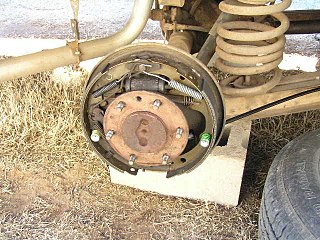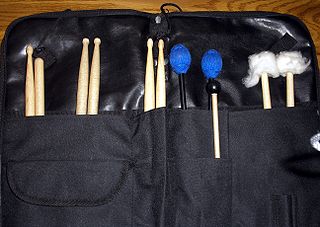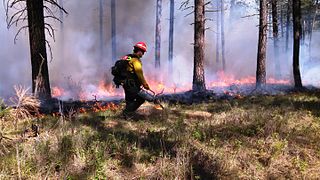Related Research Articles

The drum is a member of the percussion group of musical instruments. In the Hornbostel-Sachs classification system, it is a membranophone. Drums consist of at least one membrane, called a drumhead or drum skin, that is stretched over a shell and struck, either directly with the player's hands, or with a percussion mallet, to produce sound. There is usually a resonant head on the underside of the drum. Other techniques have been used to cause drums to make sound, such as the thumb roll. Drums are the world's oldest and most ubiquitous musical instruments, and the basic design has remained virtually unchanged for thousands of years.

A drum kit is a collection of drums, cymbals, and sometimes other auxiliary percussion instruments set up to be played by one person. The player (drummer) typically holds a pair of matching drumsticks, one in each hand, and uses their feet to operate a foot-controlled hi-hat and bass drum pedal.

Tillage is the agricultural preparation of soil by mechanical agitation of various types, such as digging, stirring, and overturning. Examples of human-powered tilling methods using hand tools include shoveling, picking, mattock work, hoeing, and raking. Examples of draft-animal-powered or mechanized work include ploughing, rototilling, rolling with cultipackers or other rollers, harrowing, and cultivating with cultivator shanks (teeth).

A drum brake is a brake that uses friction caused by a set of shoes or pads that press outward against a rotating cylinder-shaped part called a brake drum.

A toothbrush is an oral hygiene tool used to clean the teeth, gums, and tongue. It consists of a head of tightly clustered bristles, atop of which toothpaste can be applied, mounted on a handle which facilitates the cleaning of hard-to-reach areas of the mouth. They should be used in conjunction with something to clean between the teeth where the bristles of the toothbrush cannot reach - for example floss, tape or interdental brushes.

A chainsaw is a portable gasoline-, electric-, or battery-powered saw that cuts with a set of teeth attached to a rotating chain driven along a guide bar. It is used in activities such as tree felling, limbing, bucking, pruning, cutting firebreaks in wildland fire suppression, and harvesting of firewood. Chainsaws with specially designed bar-and-chain combinations have been developed as tools for use in chainsaw art and chainsaw mills. Specialized chainsaws are used for cutting concrete during construction developments. Chainsaws are sometimes used for cutting ice; for example, ice sculpture and winter swimming in Finland.

A percussion mallet or beater is an object used to strike or beat a percussion instrument in order to produce its sound.

A controlled or prescribed burn, also known as hazard reduction burning, backfire, swailing, or a burn-off, is a fire set intentionally for purposes of forest management, fire suppression, farming, prairie restoration or greenhouse gas abatement. A controlled burn may also refer to the intentional burning of slash and fuels through burn piles. Fire is a natural part of both forest and grassland ecology and controlled fire can be a tool for foresters.

Clearcutting, clearfelling or clearcut logging is a forestry/logging practice in which most or all trees in an area are uniformly cut down. Along with shelterwood and seed tree harvests, it is used by foresters to create certain types of forest ecosystems and to promote select species that require an abundance of sunlight or grow in large, even-age stands. Logging companies and forest-worker unions in some countries support the practice for scientific, safety and economic reasons, while detractors consider it a form of deforestation that destroys natural habitats and contributes to climate change.
The Quake engine is the game engine developed by id Software to power their 1996 video game Quake. It featured true 3D real-time rendering and is now licensed under the terms of GNU General Public License v2.0 or later.

A tree chipper or woodchipper is a machine used for reducing wood into smaller woodchips. They are often portable, being mounted on wheels on frames suitable for towing behind a truck or van. Power is generally provided by an internal combustion engine from 2 to 700 kilowatts. There are also high power chipper models mounted on trucks and powered by a separate engine. These models usually also have a hydraulic winch.
Bakke Mountain is a summit located in the town of Florida, Massachusetts. It was named for Master Sergeant Roald Bakke, who died in the collapse of Texas Tower 4. The mountain is the scene of wildlife and forest conservation efforts and serves as one of the primary sites of the Hoosac Wind Project. The Bakke Mountain Wind Farm is an alternative energy wind plant located on the mountain.

The güira is a percussion instrument from the Dominican Republic used as a percussion instrument in merengue, bachata, and to a lesser extent, other genres such as cumbia. It is made of a metal sheet and played with a stiff brush, thus being similar to the Haitian graj and the Cuban guayo and güiro. Güira, guayo and güiro all have a function akin to that of the indigenous native maracas or the trap-kit's hi-hat, namely providing a complementary beat.

A toilet brush is a tool for cleaning a toilet bowl.

Handcrews are diverse teams of career and temporary wildland firefighters. The crews typically consist of 18 to 20 firefighters but can also contain 4 to 6 and 8 to 10. These crews have the responsibilities of constructing firelines – strips of land cleared of flammable materials and dug down to mineral soil. These lines are generally constructed around wildfires to control them. Another type of line handcrews create is saw line. This is line where all trees limbs are removed up to shoulder height and all small trees and brush is cut down. All the limbs and trees are then carried outside the line and scattered. These are also called ladder fuels that allow the fire to climb up into the canopies which makes controlling a fire much more difficult. Sawyers do the cutting and swampers do the moving of the debris. Depending on the size of the crew there can be between 1 and 5 swampers per sawyer. Other jobs include burn outs, gridding for spot fires, and mop up after the fire is controlled.

A bush hog or "brush hog" is a type of rotary mower. Typically these mowers attach to the back of a farm tractor using the three-point hitch and are driven via the power take-off (PTO). It has blades that are not rigidly attached to the drive like a lawnmower blade, but are on hinges so if the blade hits a rock or stump, it bounces backward and inward, and then centrifugal force makes it go outwards again.

Oral hygiene is the practice of keeping one's mouth clean and free of disease and other problems by regular brushing of the teeth and cleaning between the teeth. It is important that oral hygiene be carried out on a regular basis to enable prevention of dental disease and bad breath. The most common types of dental disease are tooth decay and gum diseases, including gingivitis, and periodontitis.

The bodhrán is a frame drum used in Irish music ranging from 25 to 65 cm (10–26 in) in diameter, with most drums measuring 35–45 cm (14–18 in). The sides of the drum are 9–20 cm deep. A goatskin head is tacked to one side. The other side is open-ended for one hand to be placed against the inside of the drum head to control the pitch and timbre.

Three-drum boilers are a class of water-tube boiler used to generate steam, typically to power ships. They are compact and of high evaporative power, factors that encourage this use. Other boiler designs may be more efficient, although bulkier, and so the three-drum pattern was rare as a land-based stationary boiler.

Forestry mulching is a land clearing method that uses a single machine to cut, grind, and clear vegetation.